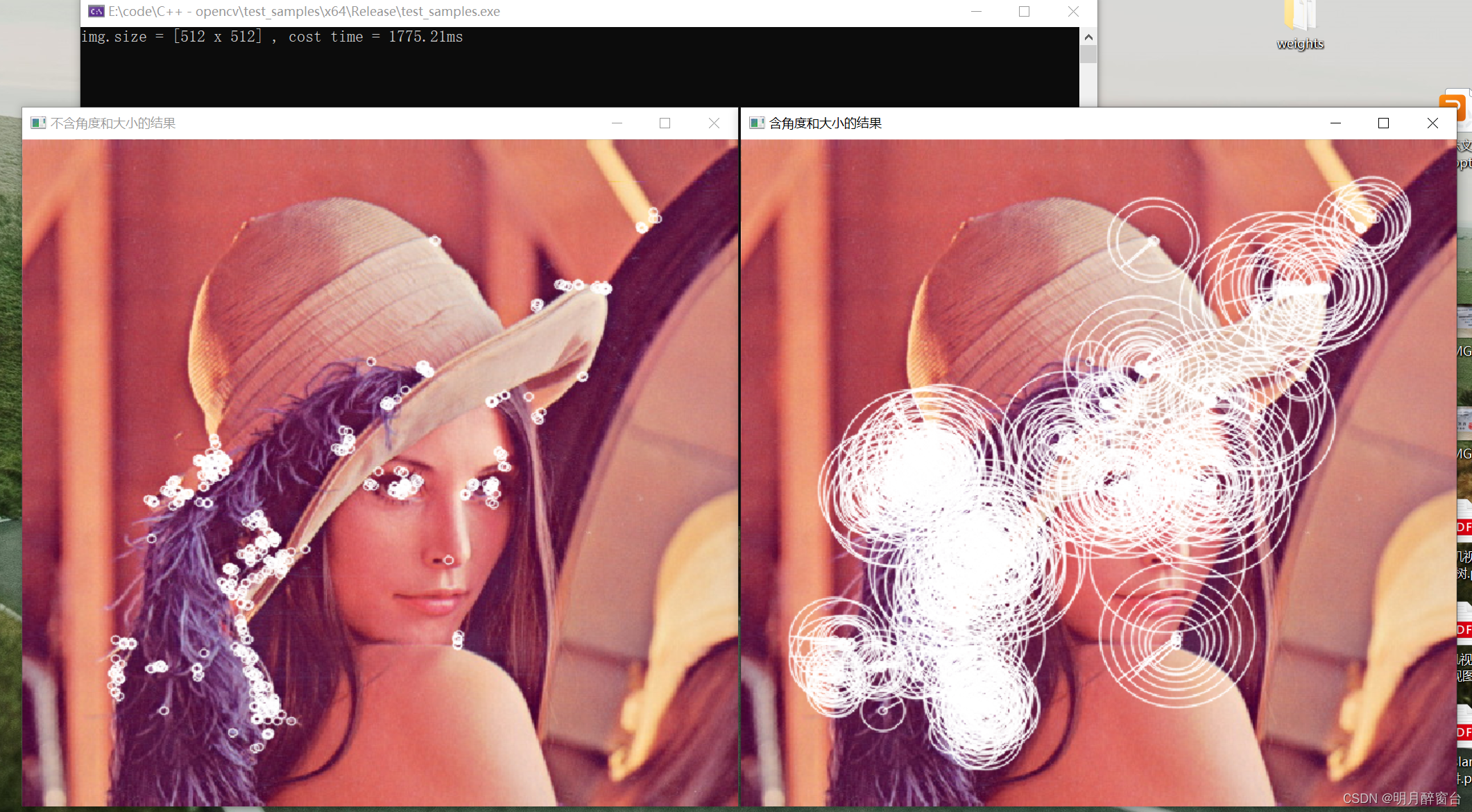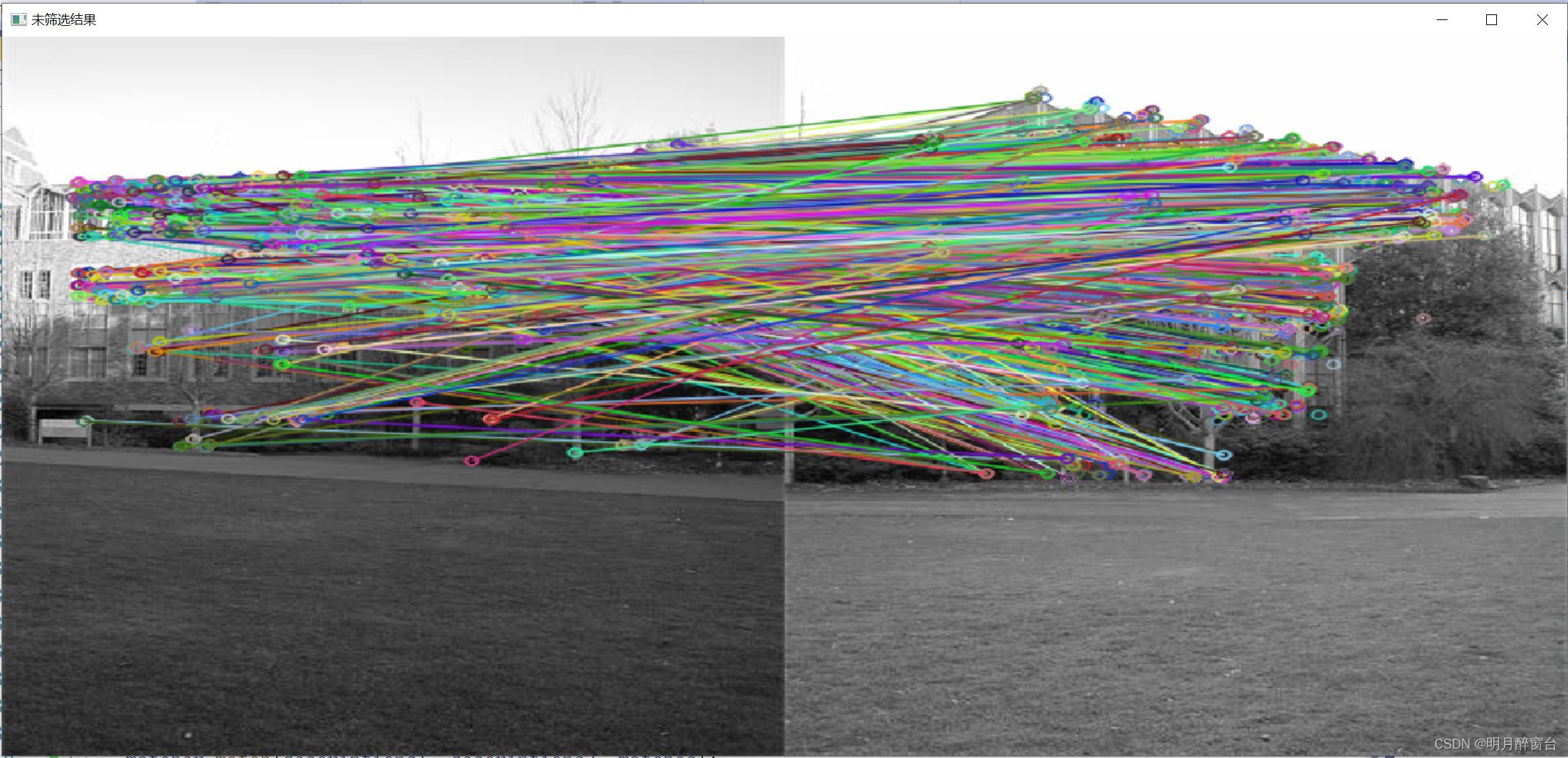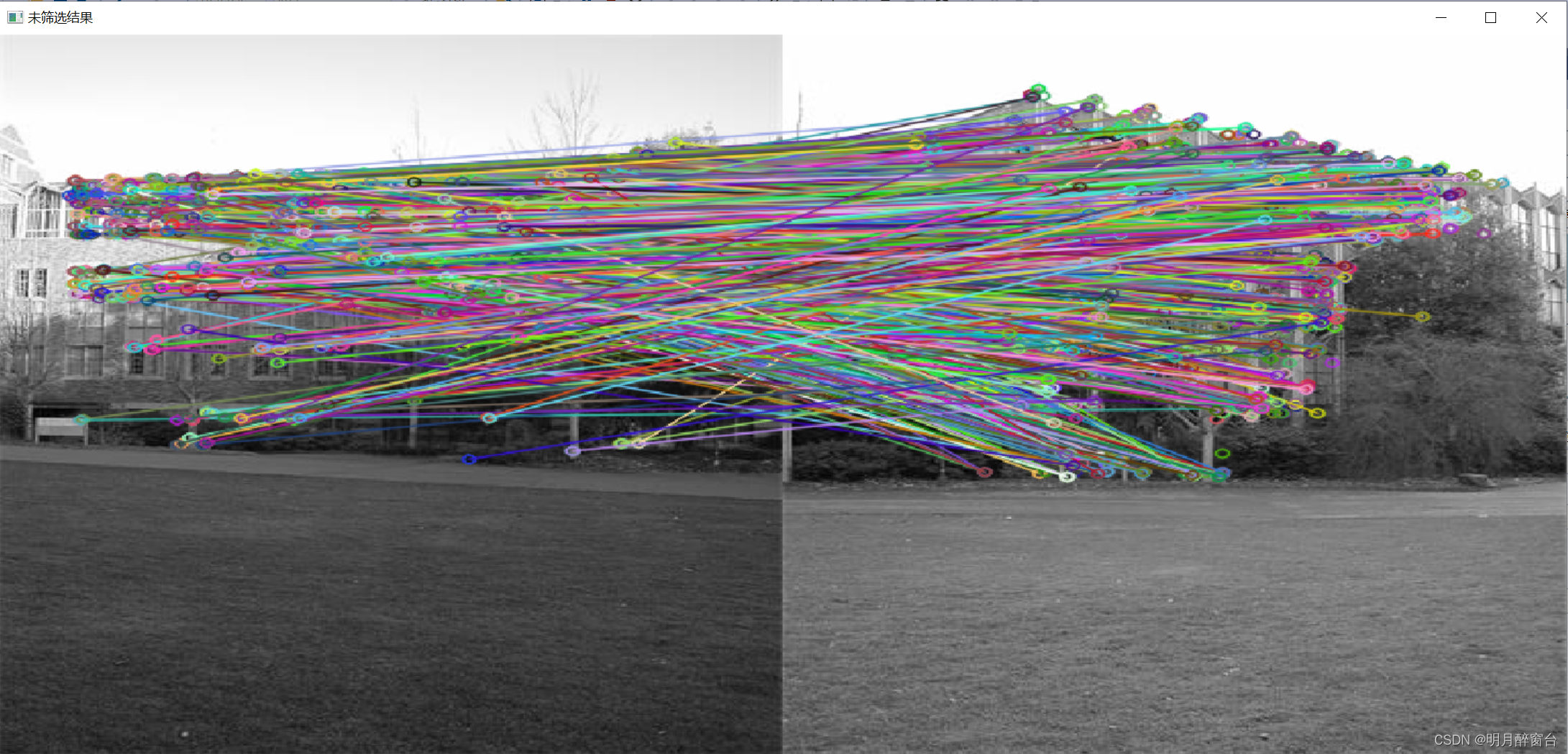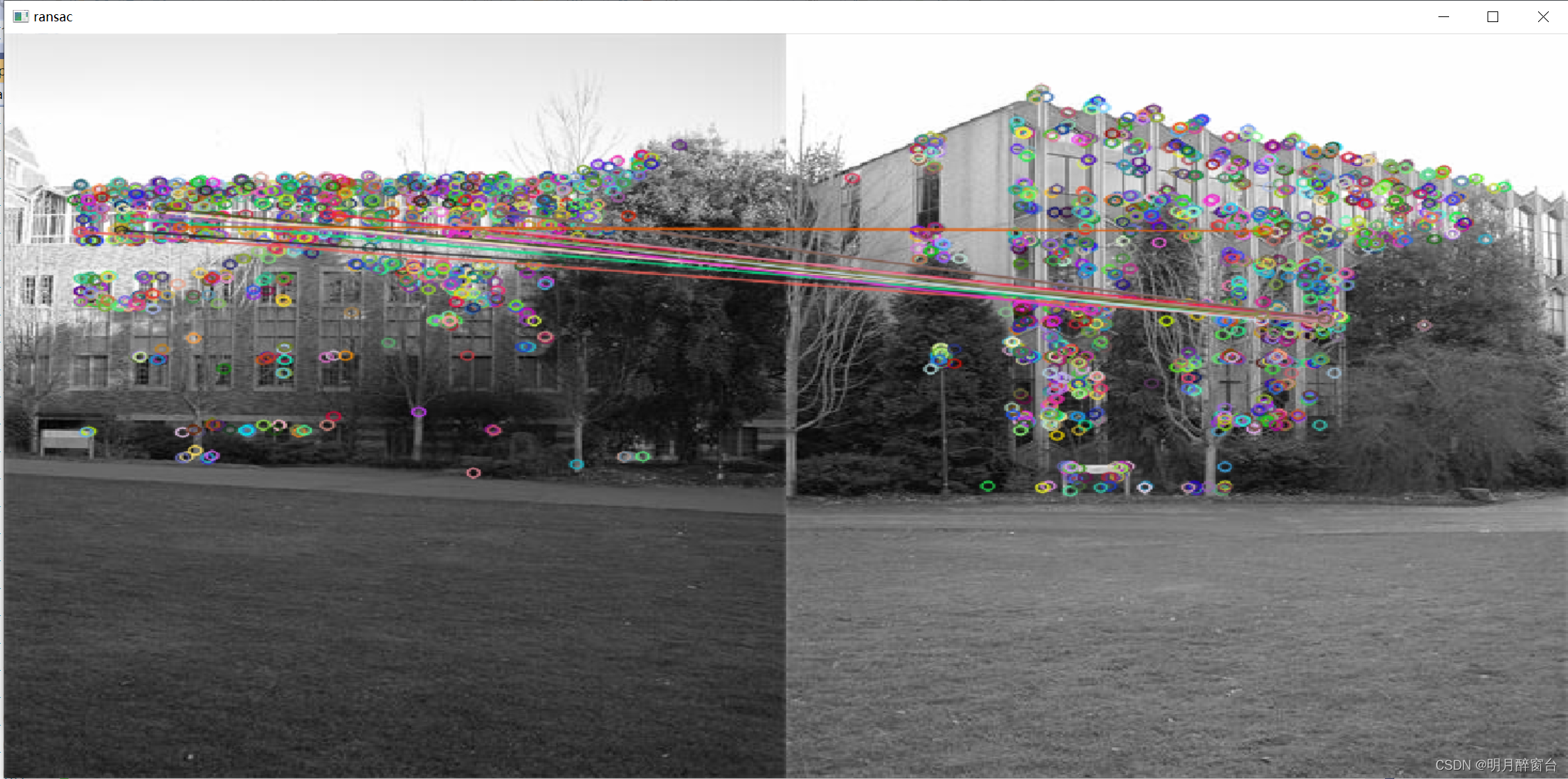Opencv 之ORB特征提取与匹配API简介及使用例程
- ORB因其速度较快常被用于视觉SLAM中的位姿估计、视觉里程、图像处理中的特征提取与匹配及图像拼接等领域
- 本文将详细给出使用例程及实现效果展示
1. API 简介
- 创建
static Ptr<ORB> cv::ORB::create (
int nfeatures = 500, //nfeatures 最终输出最大特征点数目
float scaleFactor = 1.2f, // scaleFactor 金字塔上采样比率
int nlevels = 8, // nlevels 金字塔层数
int edgeThreshold = 31, // edgeThreshold 边缘阈值
int firstLevel = 0,
int WTA_K = 2, // WTA_K这个是跟BRIEF描述子用的
ORB::ScoreType scoreType = ORB::HARRIS_SCORE, // scoreType 对所有的特征点进行排名用的方法
int patchSize = 31,
int fastThreshold = 20
)
- 检测
void cv::Feature2D::detect ( InputArray image, //输入图像
std::vector< KeyPoint > & keypoints, //待搜索特征点
InputArray mask = noArray() //操作掩码
)
- 计算
void cv::Feature2D::compute ( InputArrayOfArrays images, //输入图像
std::vector< std::vector< KeyPoint > > & keypoints,
OutputArrayOfArrays descriptors //描述子
)
- 检测与计算
void cv::Feature2D::detectAndCompute ( InputArray image,
InputArray mask,
std::vector< KeyPoint > & keypoints,
OutputArray descriptors,
bool useProvidedKeypoints = false
)
- 绘制特征点
void cv::drawMatches ( InputArray img1,
const std::vector< KeyPoint > & keypoints1,
InputArray img2,
const std::vector< KeyPoint > & keypoints2,
const std::vector< DMatch > & matches1to2,
InputOutputArray outImg,
const Scalar & matchColor = Scalar::all(-1),
const Scalar & singlePointColor = Scalar::all(-1),
const std::vector< char > & matchesMask = std::vector< char >(),
DrawMatchesFlags flags = DrawMatchesFlags::DEFAULT
)
- 绘制匹配点对
void cv::drawMatches ( InputArray img1,
const std::vector< KeyPoint > & keypoints1,
InputArray img2,
const std::vector< KeyPoint > & keypoints2,
const std::vector< DMatch > & matches1to2,
InputOutputArray outImg,
const Scalar & matchColor = Scalar::all(-1),
const Scalar & singlePointColor = Scalar::all(-1),
const std::vector< char > & matchesMask = std::vector< char >(),
DrawMatchesFlags flags = DrawMatchesFlags::DEFAULT
)
2. 特征提取
- 讲述特征点提取与描述子计算,实现如下:
int main()
{
Mat img = imread("./data/test3/lena.png");
if (!img.data || img.empty())
{
cout << "图像读取错误!" << endl;
return -1;
}
//创建ORB关键点
Ptr<ORB> orb = ORB::create(500, 1.2f);
double t1 = getTickCount();
vector<KeyPoint>Keypoints;
Mat descriptions;
#if 0
//计算ORB关键点
orb->detect(img, Keypoints);
//计算ORB描述子
orb->compute(img, Keypoints, descriptions);
#else
orb->detectAndCompute(img, cv::Mat(), Keypoints, descriptions);
#endif // 0
double t2 = (getTickCount() - t1) / getTickFrequency() * 1000;
cout << "img.size = " << img.size() << " , cost time = " << t2 << "ms\n";
//绘制特征点
Mat imgAngle;
img.copyTo(imgAngle);
//绘制不含角度和大小的结果
drawKeypoints(img, Keypoints, img, Scalar(255, 255, 255));
//绘制含有角度和大小的结果
drawKeypoints(img, Keypoints, imgAngle, Scalar(255, 255, 255), DrawMatchesFlags::DRAW_RICH_KEYPOINTS);
//显示结果
string wname1 = "不含角度和大小的结果", wname2 = "含角度和大小的结果";
namedWindow(wname1, WINDOW_NORMAL);
namedWindow(wname2, 0);
imshow(wname1, img);
imshow(wname2, imgAngle);
waitKey(0);
return 1;
}

3. 特征匹配
- 暴力匹配实现:
#include<iostream>
#include<opencv2/opencv.hpp>
#include<vector>
using namespace std;
using namespace cv;
int main()
{
//灰度格式读取
Mat img1, img2;
img1 = imread("./data/test3/1.jpg",IMREAD_GRAYSCALE);
img2 = imread("./data/test3/2.jpg",0);
if (img1.empty() || img2.empty())
{
cout << "img.empty!!!\n";
return -1;
}
//提取orb特征点
vector<KeyPoint>Keypoints1, Keypoints2;
Mat descriptions1, descriptions2;
//计算特征点
orb_features(img1, Keypoints1, descriptions1);
orb_features(img2, Keypoints2, descriptions2);
//特征点匹配
vector<DMatch>matches;
BFMatcher matcher(NORM_HAMMING); //定义特征点匹配的类,使用汉明距离
matcher.match(descriptions1, descriptions2, matches);
cout << "matches = " << matches.size() << endl;
//通过汉明距离筛选匹配结果
double min_dist = 10000, max_dist = 0;
for (int i = 0; i < matches.size(); ++i)
{
double dist = matches[i].distance;
min_dist = min_dist < dist ? min_dist : dist;
max_dist = max_dist > dist ? max_dist : dist;
}
//输出计算的最大、最小距离
cout << "min_dist = " << min_dist << endl;
cout << "max_dist = " << max_dist << endl;
//通过距离提出误差大的点
vector<DMatch>goodmatches;
for (int i = 0; i < matches.size(); ++i)
{
if (matches[i].distance <= MAX(1.8 * min_dist, 30)) //需调参
{
goodmatches.push_back(matches[i]);
}
}
cout << "good_min = " << goodmatches.size() << endl;
//绘制结果
Mat outimg, outimg1;
drawMatches(img1, Keypoints1, img2, Keypoints2, matches, outimg);
drawMatches(img1, Keypoints1, img2, Keypoints2, goodmatches, outimg1);
string wname1 = "未筛选结果", wname2 = "最小汉明距离筛选";
namedWindow(wname1, WINDOW_NORMAL);
namedWindow(wname2, 0);
imshow(wname1, outimg);
imshow(wname2, outimg1);
waitKey(0);
return 1;
}
其效果如下:


- 最近邻匹配实现如下:
if (descriptions1.type() != CV_32F)
{
descriptions1.convertTo(descriptions1, CV_32F);
descriptions2.convertTo(descriptions2, CV_32F);
}
//特征点匹配
vector<DMatch>matches;
FlannBasedMatcher matcher; //定义特征点匹配的类,使用汉明距离
matcher.match(descriptions1, descriptions2, matches);
cout << "matches = " << matches.size() << endl;
//通过汉明距离筛选匹配结果
double min_dist = 10000, max_dist = 0;
for (int i = 0; i < matches.size(); ++i)
{
double dist = matches[i].distance;
min_dist = min_dist < dist ? min_dist : dist;
max_dist = max_dist > dist ? max_dist : dist;
}
//输出计算的最大、最小距离
cout << "min_dist = " << min_dist << endl;
cout << "max_dist = " << max_dist << endl;
//通过距离提出误差大的点
vector<DMatch>goodmatches;
for (int i = 0; i < matches.size(); ++i)
{
if (matches[i].distance <= 0.6 * max_dist) //需调参
{
goodmatches.push_back(matches[i]);
}
}
cout << "good_min = " << goodmatches.size() << endl;
其效果如下:


- RANSAC优化匹配
void ransac(vector<DMatch>matches, vector<KeyPoint>queryKeyPoint,
vector<KeyPoint>trainKeyPoint, vector<DMatch>& matches_ransac)
{
//定义保存匹配点对坐标
vector<Point2f>srcPoints(matches.size()), dstPoints(matches.size());
//保存从关键点中提取到的匹配点对坐标
for (int i = 0; i < matches.size(); ++i)
{
srcPoints[i] = queryKeyPoint[matches[i].queryIdx].pt;
dstPoints[i] = trainKeyPoint[matches[i].trainIdx].pt;
}
//匹配点对RANSAC过滤
vector<int>inlierMask(srcPoints.size());
findHomography(srcPoints, dstPoints, RANSAC, 5, inlierMask);
//手动保留RANSAC过滤后的匹配点对
for (int i = 0; i < inlierMask.size(); ++i)
{
if (inlierMask[i])
matches_ransac.push_back(matches[i]);
}
}
//*************************RANSAC*******************************************
//main函数中放在暴力匹配代码后:
//特征点匹配
vector<DMatch>matches;
BFMatcher matcher(NORM_HAMMING); //定义特征点匹配的类,使用汉明距离
matcher.match(descriptions1, descriptions2, matches);
cout << "matches = " << matches.size() << endl;
//通过汉明距离筛选匹配结果
double min_dist = 10000, max_dist = 0;
for (int i = 0; i < matches.size(); ++i)
{
double dist = matches[i].distance;
min_dist = min_dist < dist ? min_dist : dist;
max_dist = max_dist > dist ? max_dist : dist;
}
//输出计算的最大、最小距离
cout << "min_dist = " << min_dist << endl;
cout << "max_dist = " << max_dist << endl;
//通过距离提出误差大的点
vector<DMatch>goodmatches;
for (int i = 0; i < matches.size(); ++i)
{
if (matches[i].distance <= MAX(1.8 * min_dist, 30)) //需调参
{
goodmatches.push_back(matches[i]);
}
}
cout << "good_min = " << goodmatches.size() << endl;
//RANSAC优化:
vector<DMatch>good_ransac;
ransac(goodmatches, Keypoints1, Keypoints2, good_ransac);
cout << "good_ransac = " << good_ransac.size() << endl;
Mat output_;
drawMatches(img1, Keypoints1, img2, Keypoints2, good_ransac, output_);
namedWindow("ransac", 0);
imshow("ransac", output_);
